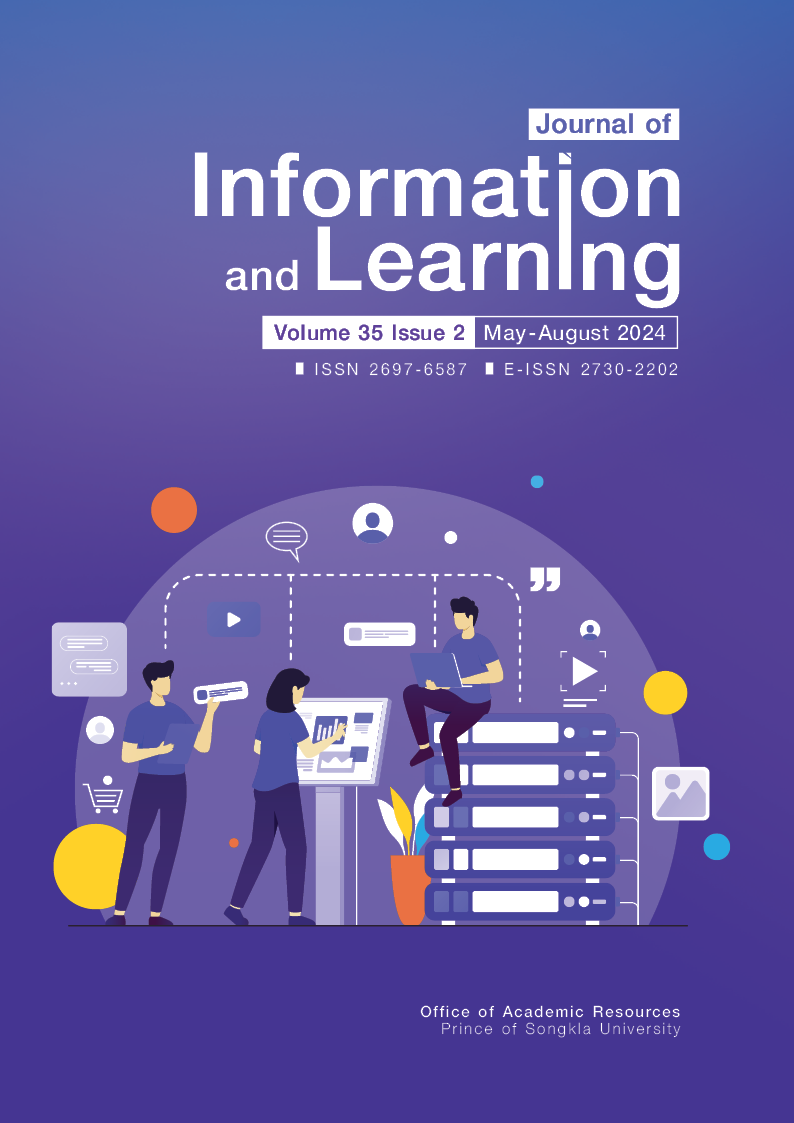The Development of Chatbot System for Cooperative and Work-Integrated Education Using Machine Learning Method
Main Article Content
Abstract
The objectives of this research ware 1) to create a model and determine the efficiency of question classification models, 2) to develop a chatbot system for cooperative and work-integrated education, and 3) to investigate user satisfaction with the chatbot system for cooperative and work- integrated education. The target group consisted of 68 fourth-year students majoring in Information Technology at the Faculty of Information Technology, Rajabhat Maha Sarakham University, who were undertaking cooperative education in the academic year 2022. The research tools used included: 1) a dataset of questions related to cooperative and work-integrated education, 2) a chatbot system for cooperative and work-integrated education, 3) a user satisfaction survey questionnaire for the chatbot system. The research findings suggest that among the models developed and tested for classifying question types, the Decision Tree and Multilayer Perceptron models achieved the highest accuracy at 93.7%, while the K-Nearest Neighbors method reached 78.4%. Additionally, the developed chatbot system for cooperative and work-integrated education, integrated into the Line application, demonstrated accurate and efficient question-answering capabilities when paired with the model. Moreover, the overall satisfaction evaluation of the chatbot system revealed a high level of satisfaction, with an average score of 4.63 and a standard deviation of 0.65. Overall, the research indicates that the developed chatbot system operates efficiently and meets users' needs.
Article Details

This work is licensed under a Creative Commons Attribution-NonCommercial-NoDerivatives 4.0 International License.
The Journal of Information and Learning is operated by the Office of Academic Resources, Prince of Songkla University. All articles published in the journal are protected by Thailand copyright law. This copyright covers the exclusive rights to share, reproduce and distribute the article, including in electronic forms, reprints, translations, photographic reproductions, or similar. Authors own copyrights in the works they have created as well as the Office of Academic Resources. The Journal reserves the right to edit the language of papers accepted for publication for clarity and correctness, as well as to make formal changes to ensure compliance with the journal's guidelines. All authors must take public responsibility for the content of their paper.
References
Budsabok, S., Pechpong, N., & Singtokaeo, C. (2020). Development of chatbot application for student services case study: Division of Student Development Rajamangala University of Technology Suvarnabhumi. Journal of Applied Research on Science and Technology, 19(2), 85-94. https://doi.org/10.14456/rj-rmutt.2020.20
Chanchaisilp, S., & Chooprayoon, V. (2020). Assessment of efficiency, effectiveness and satisfaction in chatbot usability of the banks in Thailand. RSU Library Journal, 26(1), 117-136. https://rilj.rsu.ac.th/journal/51/article/215
Chitiyaphol, J., & Dornpinij, P. (2022). Developing an information system for learning computer network vocabulary through the line chatbot application. Interdisciplinary Academic and Research Journal, 2(4), 607-618. https://doi.org/10.14456/iarj.2022.78
Glorot, X., Bordes, A., & Bengio, Y. (2011, April 11-13). Deep sparse rectifier neural networks [Conference session]. 14th International Conference on Artificial Intelligence and Statistics, Fort Lauderdale, FL, USA. https://proceedings.mlr.press/v15/glorot11a.html
Han, J., Pei, J., & Tong, H. (2022). Data mining concepts and techniques (4th ed.). Morgan Kaufmann.
Jabri, S., Dahbi, A., Gadi, T., & Bassir, A. (2018, June 4). Ranking of text documents using TF-IDF weighting and association rules mining [Conference session]. 4th International Conference on Optimization and Applications (ICOA), Mohammedia, Morocco. https://doi.org/10.1109/ICOA.2018.8370597
Kadhim, A. I. (2019). Survey on supervised machine learning techniques for automatic text classification. Artificial Intelligence Review, 52(1), 273-292. https://doi.org/10.1007/s10462-018-09677-1
Likert, R. (1932). A technique for the measurement of attitudes. Archives of Psychology, 22(140), 55. https://psycnet.apa.org/record/1933-01885-001
Naksutthi, E. (2017). Chatbot: A communication platform for smart classroom [Master's thesis, King Mongkut's University of Technology North Bangkok]. ThaiLIS Digital Collection. https://tdc.thailis.or.th/tdc/dccheck.php?Int_code=52&RecId=32113&obj_id=200538&showmenu=no
Nasritha, K., Kerdprasop, K., & Kerdprasop, N. (2018). Comparison of sampling techniques for imbalanced data classification. Journal of Applied Informatics and Technology, 1(1), 20-37. https://doi.org/10.14456/jait.2018.2
Office of the Ministry of Higher Education, Science, Research and Innovation. (2022). Cooperative and work integrated education: CWIE. Ministry of Higher Education, Science, Research and Innovation. https://cwie.mhesi.go.th/serviceDetail/x3a213e234
Polrob, J., Rodjanadid, B., Tanthanuch, J., & Schulz, E. (2023). Application of binary whale optimization algorithm for solving imbalanced data problems. Journal of Engineering and Digital Technology, 11(1), 16-29. https://ph01.tci-thaijo.org/index.php/TNIJournal/article/view/251278
Sangkatip, W., Wongsritha, W., & Pai-ngeon, P. (2023). Resume classification system using machine learning method. Journal of Technology Management Rajabhat Maha Sarakham University, 10(2), 32-46. https://ph02.tci-thaijo.org/index.php/itm-journal/article/view/249964
Sangkrajang, K., & Tangwannawit, P. (2020). Messenger’s chatbot based on artificial intelligence for digital library service. Life Sciences and Environment Journal, 21(2), 468-480. https://ph01.tci-thaijo.org/index.php/psru/article/view/242317
Sangtong, K., & Tongtep, N. (2023). Exploring the potential of cooperative education students from the corporation perspective to enhance cooperative and work-integrated education (CWIE): A case study of Prince of Songkla University, Phuket Campus. Journal of Information and Learning, 34(3), 46-61. https://so04.tci-thaijo.org/index.php/jil/article/view/267092
Shalev-Shwartz, S., & Ben-David, S. (2014). Understanding machine learning: From theory to algorithms. Cambridge University Press: United States of America.
Sumruamjit, U., Roosomkai, P., & Wongpattananipas, P. (2023). Developing a chatbot application with dialogflow providing advice on positive depressive disorder concepts for the elderly. Journal of Industrial Education, 22(1), 75-87. https://ph01.tci-thaijo.org/index.php/JIE/article/view/250560
Zhang, S., Li, X., Zong, M., Zhu, X., & Wang, R. (2018). Efficient kNN classification with different numbers of nearest neighbors. IEEE Transactions on Neural Networks and Learning Systems, 29(5), 1774-1785. https://doi.org/10.1109/TNNLS.2017.2673241


